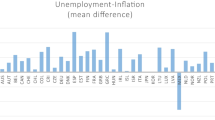Abstract
This study estimates the equilibrium real and nominal exchange rates for five Central and Eastern European (CEE) countries. A new approach is adopted, which combines the fundamental equilibrium exchange rate (FEER) with the behavioural equilibrium exchange rate (BEER) methodology. In a VAR-based 3-equation cointegration system, we estimate structural equations for internal and external balances and link them to the real exchange rate. The estimated misalignment is used to derive equilibrium nominal exchange rates. The sustainability of an ERM-II-type exchange rate regime is investigated on ex post data, and the credibility problem of fixing the currencies of CEE countries vis-à-vis the single European currency is analysed. JEL no. E31, F31, O11, P17
Similar content being viewed by others
References
Aglietta, M., C. Baulant, and V. Coudert (1998). Compétitivité et régime de change en Europe Centrale. CEPII Working Paper 10. Centre d’Études Prospectives et d’Informations Internationales, Paris.
Baffes, J., I. Elbadawi, and S. O’Connell (1999). Single Equation of the Equilibrium Real Exchange Rate. In L. Hinkle and P. Montiel (eds.),Exchange Rate Misalignments: Concepts and Measurement for Developing Countries. A World Bank Research Publication. New York: Oxford University Press.
Clark, P. B., and R. MacDonald (1998). Exchange Rates and Economic Fundamentals: A Methodological Comparison of BEERs and FEERs. IMF Working Paper 67. IMF, Washington, D.C.
Clark, P. B., and R. MacDonald (2000). Filtering the BEER — A Permanent and Transitory Decomposition. IMF Working Paper 144. IMF, Washington, D.C.
Coricelli, F., and B. Jazbec (2001). Real Exchange Rate Dynamics in Transition Economies. Centre for Economic Policy Research Discussion Papers Series 2869. CEPR, London.
De Gregorio, J., and H. Wolf (1994). Terms of Trade, Productivity, and the Real Exchange Rate. NBER Working Paper 4807. National Bureau of Economic Research, Cambridge, Mass.
De Gregorio, J., A. Giovannini, and H. Wolf (1994). International Evidence on Tradable and Nontradable Inflation.European Economic Review 38: 1225–1244.
Edwards, S. (1994). Real and Monetary Determinants of Real Exchange Rate Behavior: Theory and Evidence from Developing Countries. In J. Williamson (ed.),Estimating Equilibrium Exchange Rates. Washington, D.C.: Institute for International Economics.
Égert, B. (2002a). Estimating the Impact of the Balassa-Samuelson Effect on Inflation and the Real Exchange Rate during the Transition.Economic Systems 26 (1): 1–16.
Égert, B. (2002b). Investigating the Balassa-Samuelson Hypothesis in the Transition: A Panel Study.The Economics of Transition 10 (2): 279–309.
Égert, B. (2002c). Equilibrium Real Exchange Rates in Central Europe’s Transition Economies: Knocking on Heaven’s Door. William Davidson Institute Working Paper 480. William Davidson Institute, Ann Arbor.
Égert, B. (2003). Nominal and Real Convergence in Estonia: The Balassa-Samuelson (Dis)Connection. Tradable Goods, Regulated Prices, and Other Culprits. Working Paper 4. Bank of Estonia, Tallinn.
Égert, B., I. Drine, K. Lommatzsch, and Ch. Rault (2003). The Balassa-Samuelson Effect in Central and Eastern Europe: Myth or Reality?Journal of Comparative Economics 31 (3): 552–572.
Elbadawi, I. (1994) Estimating Long-Run Equilibrium Real Exchange Rates. In J. Williamson (ed.),Estimating Equilibrium Exchange Rates. Washington, D.C.: Institute for International Economics.
Filipozzi, F. (2000). Equilibrium Exchange Rate of the Estonian Kroon, Its Dynamics and Its Impacts of Deviations. Working Paper 2. Bank of Estonia, Tallinn.
Flek, V., L. Marková, and J. Podpiera (2002). Sectoral Productivity and Real Exchange Rate Appreciation: Much Ado about Nothing? Working Paper 4. Czech National Bank, Prague.
Halpern, L., and C. Wyplosz (1997). Equilibrium Exchange Rates in Transition Countries.IMF Staff Papers 44 (4): 430–461.
Halpern, L., and C. Wyplosz (2001). Economic Transformation and Real Exchange Rates in the 2000s: The Balassa-Samuelson Connection.UNO Economic Survey of Europe 2001 (1): 227–239.
Hinkle, L., and P. Montiel (1999).Exchange Rate Misalignments: Concepts and Measurement for Developing Countries. A World Bank Research Publication. New York: Oxford University Press.
Kopits, G., and I. Székely (2002). Fiscal Policy Challenges of EU Accession for Central European Accession Countries. Paper presented at the East-West Conference, November 3–5, Vienna.
Kovács, M. A. (2002). On the Estimated Size of the Balassa-Samuelson Effect in Five Central and Eastern European Countries. Working Paper 5. National Bank of Hungary, Budapest.
MacDonald, R. (1997). What Determines Real Exchange Rates? The Long and Short of It. IMF Working Paper 21. International Monetary Fund, Washington, D.C.
Mihaljek, D., and M. Klau (2003). The Balassa-Samuelson Effect in Central Europe: A Disaggregated Analysis. Working Paper 143. Bank for International Settlements, Basel.
Mongradini, J. (1998). Estimating Egypt’s Equilibrium Real Exchange Rate. IMF Working Paper 5. International Monetary Fund, Washington, D.C.
Montiel, P. (1999). Determinants of the Long-Run Equilibrium Real Exchange Rate: An Analytical Model. In P. J. Montiel and L. E. Hinckle (eds.),Exchange Rate Misalignments: Concepts and Measurement for Developing Countries. A World Bank Research Publication. New York: Oxford University Press.
Stein, J. L. (1994). The Natural Real Exchange Rate of the US Dollar and Determinants of Capital Flows. In J. Williamson (ed.),Estimating Equilibrium Exchange Rates. Washington, D.C.: Institute for International Economics.
Williamson, J. (1994). Estimates of FEERs. In J. Williamson (ed.),Estimating Equilibrium Exchange Rates. Washington, D.C.: Institute for International Economics.
Author information
Authors and Affiliations
Corresponding author
About this article
Cite this article
Balázs, É., Amina, LR. Estimating the equilibrium exchange rate of the Central and Eastern European acceding countries: The challenge of euro adoption. Review of World Economics 139, 683–708 (2003). https://doi.org/10.1007/BF02653109
Issue Date:
DOI: https://doi.org/10.1007/BF02653109




